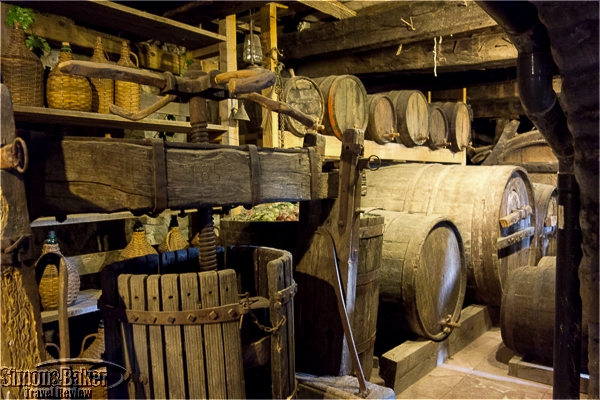Meteora, where monasteries have stood guard for half a millennium
Article and photos by Josette King

Meteora Monasteries – from left to right, Rousanou, Saint Nicholas, Varlaam and Great Meteoron
I first heard of the monasteries of Meteora (Greek for suspended in the air) some 40 years ago and immediately resolved that I must visit, someday. The year was 1975. The military dictatorship that had cast a pall upon Greece for seven years had finally ended and adventurous tourists had begun to return. A friend was telling me of her summer of wandering to the far reaches of the Thessalian Plain and coming upon a surreal landscape of sandstone pinnacles thousands of feet in height topped by fortified medieval monasteries. Built from the 14th to 16th centuries, they were one of the largest monastic complexes in Greece. Of the original 24, only six monasteries remained and were still home to small religious communities. There were no roads or other visible means of access, but she and her traveling companion had managed to visit. Area villagers had suggested they approached the monks who came down for supplies every few days. Chances were they would be allowed to go. Two days later, they were hoisted some 400 meters (1300 feet) above the plain in a basket akin to a small hot air balloon gondola attached to a sturdy rope to the Grand Meteoron Monastery (a.k.a. Monastery of the Configuration of Christ). There, a kind brother who spoke a bit of English gave them a tour of the courtyard and common areas, including a church with fascinating and remarkably well preserved post Byzantine frescoes.

The Monastery of Great Meteoron
It took four decades but the opportunity finally arose for me to keep my promise to myself, in the form of an Athens to Pindus Mountains 4 x 4 Tour with Tripology Adventures. It ended at the place where the foothills of the Pindus meet the northwestern corner of the Thessalian Plain, Meteora. Tripology is an adventure travel company that leads self-drive caravans into remote, history rich areas of the Mediterranean Basin and beyond. While the powerful 4 x 4s that had been a must to see us through the unpaved mountain trails of the Pindus were not technically necessary there, they did come in handy on the steep access road that had replaced the basket ascension of old to reach to the monasteries.

Today’s visitors access Great Meteoron via a narrow stairway
Much has changed since my friend’s visit. The Meteora complex is no longer a well-kept secret. Even before UNESCO declared it a World Heritage Site in 1988, it had already enjoyed its moment in the limelight when James Bond tracked villains to the Holly Trinity Monastery for the scenic suspense ending of his 1981 caper “For Your Eyes Only.” More recently, roads have been constructed up nearby hills with footbridges over the chasms. Visitors walk across to reach steep stone stairways that lead to entrances cut into the fortification walls. With the development of mass tourism, Meteora has become one of the most visited historic sites in Greece. And Kalambaka, the sleepy village where my friend had waited for the monks to show up, is now a thriving modern tourist town. But I enjoyed my comprehensive tour of Great Meteoron, the oldest (established around 1340) as well as the highest of the existing monasteries. With only three monks remaining in residence, most of common areas such as the original kitchen, pantry, wine cellar, refectory and the artifacts of everyday life they still hold have become museum exhibits.

The ancient wine cellar at Great Meteoron
Due to their unassailable location, these remote religious centers had become an academic and artistic safe heaven that kept Hellenic culture and traditions alive during the four centuries of Ottoman occupation of Greece from the mid 15th century to 1821. The Great Meteoron katholikon (orthodox equivalent to a conventual church in Western Christianity), the Church of the Transfiguration that was built in 1388 in the Greek square cross floor plan and topped with an unusual twelve sided dome and the nave and narthex added in 1545 are prime examples of the curatorial importance of the site. The icons adorning the sanctuary trace back to the 14th to 16th centuries. The frescoes of the katholikon, painted in the late 15th century, are in the Macedonian style. They depict the Virgin Enthroned and multiple scenes from the life of Christ, including images of Christ Pantocrator (reminiscent of early Christian mosaics in Istanbul’s Agia Sophia). The nave and narthex frescoes, painted in 1552 in the more rigid style of the Cretan school, recount the early gospels as well the gruesome martyrdom of early saints. They also include portraits of the monastery’s founders Athanasios and Ioajph. In addition to their artistic and historic documentary importance, it was a thrill to see ancient frescoes that had been so well protected by their isolated environment that they were still in their original state and in remarkable condition.

The Monastery of Varlaam
My visit ended with a quiet moment in the shaded courtyard, taking in the dramatic views of the nearby pinnacles and the valley beyond. Despite their world fame, the monasteries serenely go on standing guard, suspended in the sky as they have for over half a millennium. A breathtaking sight that alone would have made it worth my decades long wait.








